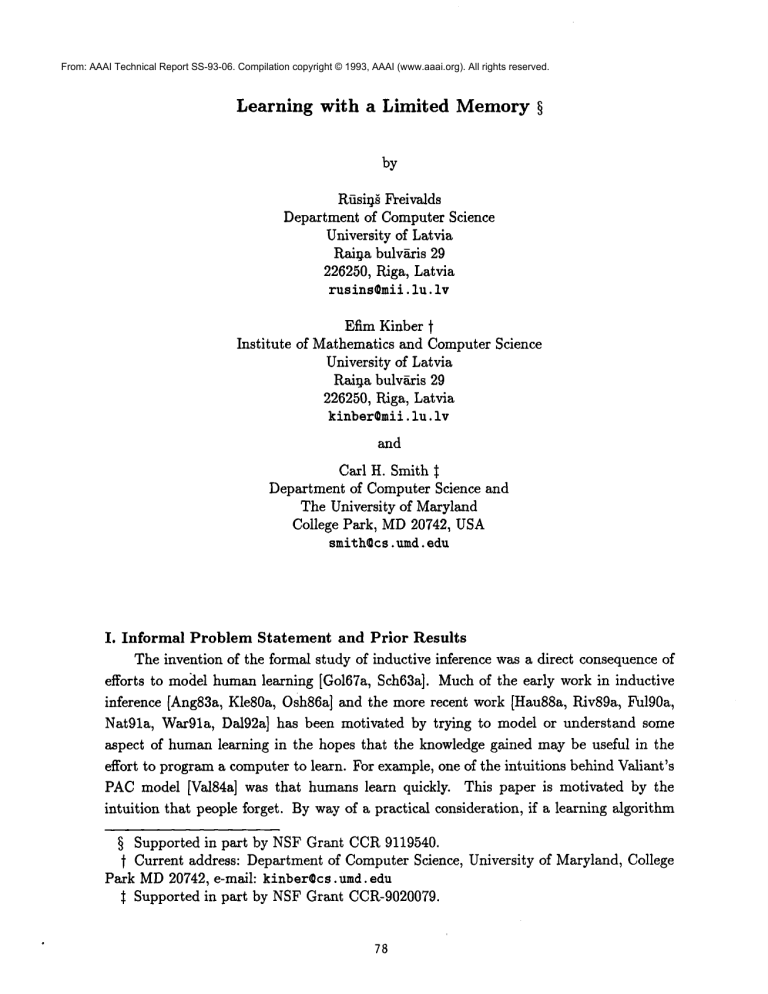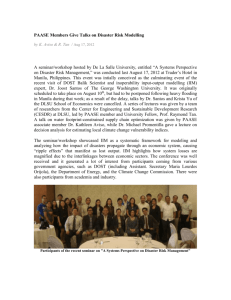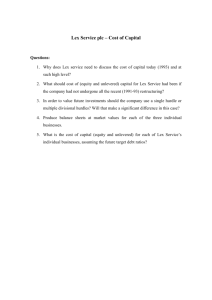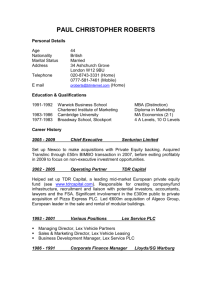
From: AAAI Technical Report SS-93-06. Compilation copyright © 1993, AAAI (www.aaai.org). All rights reserved.
Learning with a Limited Memory§
by
Rfisi~§ Freivalds
Department of Computer Science
University of Latvia
Rai~a bulv~ris 29
226250, Riga, Latvia
rusins@mii,
lu. Iv
Institute
Efim Kinber t
of Mathematics and Computer Science
University of Latvia
Rai~a bulv~ris 29
226250, Riga, Latvia
kinber~mi±,
lu. iv
and
Carl H. Smith $
Department of Computer Science and
The University of Maryland
College Park, MD20742, USA
smith@cs,
umd.edu
I. Informal Problem Statement and Prior Results
The invention of the formal study of inductive inference was a direct consequence of
efforts to moclel humanlearning [Go167a, Sch63a]. Muchof the early work in inductive
inference [Ang83a, Kle80a, Osh86a] and the more recent work [Hau88a, RivS9a, Ful90a,
Nat91a, War91a, Da192a] has been motivated by trying to model or understand some
aspect of humanlearning in the hopes that the knowledge gained may be useful in the
effort to programa computer to learn. For example, one of the intuitions behind Valiant’s
PAC model [Val84a] was that humans learn quickly. This paper is motivated by the
intuition that people forget. By wayof a practical consideration, if a learning algorithm
§ Supported in part by NSF Grant CCR9119540.
t Current address: Department of Computer Science, University of Maryland, College
Park MD20742, e-mail: kinber@cs.umd, edu
:~ Supported in part by NSF Grant CCR-9020079.
78
were to remember (store) all its examples then either memorywould be exceeded or
unacceptable amount of time would be taken in searching through the data.
Other researchers have also considered learning algorithms with a limited amount of
memory[Hea90a, Miy87a, Miy89a, Osh86a, Wex80a, Wie76a]. All of these studies were
register based in that the learning machines that were studied were limited as to howmany
samples and prior conjectures could be stored in memory.The size of each conjecture or
sample was unrestricted.
As in the standard RAMmodel of computation, each of the
values to be stored was assumedto fit into a register. The PACmodel, and its derivatives,
also implicitly entail a restriction on the numberof samples to be retained by a learning
algorithm. Since a PACalgorithm must finish in a polynomial amount of time it can only
have seen a polynomial amount of examples. The size of the individual examples is not
discussed, hence these models do not account for storage utilization.
A complexity theoretic study of space bounded learning machines was initiated in
[Fre92a]. The Gold model of learning in the limit was employed. The machines under
consideration were allowed only a constant numberof bits to store information. The main
result from that paper was that there is a class of recursive functions that cannot be learned
in a constant amount of space by any deterministic learning machine, but can be learned
in a small constant amountof space by a probabilistic learning machine, with probability
1. The contribution of this paper is to further refine the model of memorylimited learning
and obtain sharper results concerning deterministic memorylimited learning.
II. New Results
Wenowdiscuss the results of this paper. This paper introduces two refinements of the
model used in [Fre92a]. Firstly, memorybounds as a function of the size of the input seen
so far are used, as opposed to constant size memoryonly. Secondly, both long and short
term memories are employed. The long term memoryis used to remember the samples
received as input, prior conjectures, and state information for the underlying finite state
device that is the learning mechanism. The short term memoryis annihilated every time
a new input is read or a new conjecture is output. An easy result that imposes a boundary
on the mathematical landscape is:
¯ For any class of recursive functions that can be learned, there is a learning algorithm
that learns the class using only a linear amount of long term memory.Furthermore,
with a little care, the constants involved can be madevery small (less than 2 ¯ n+
the size of the state information from the witness that the class you started with is
learnable) and short term memoryrequirements can simultaneously be reduced to 0.
Our other results fall into three categories: LowerBounds, Presentation Orders and Trade
of[s.
79
Lower Bounds
In this section we have two lower bound results and a gap theorem. The first indicates that sometimes the absolute upper bound on the long term storage requirements is
necessary.
¯ There is a class of recursive functions requiring linear long term storage (the functions
of finite support).
¯ There is a class requiring logarithmic long term storage (the class used in the probabilistic result from [Fre92a].)
Our most striking result is a gap theorem for the dense classes of recursive functions. A
class is dense if any finite function can be extended to a function in the class. For example,
the self describing functions, and the functions of finite support are dense.
¯ For any dense class that is learnable, either there is a learning algorithm that learns
the class using at most a constant amount of long term memoryor any algorithm that
learns the class uses at least a logarithmic amountof long term storage, for infinitely
manyinput sizes.
The above result seems to have the following explanation. With logarithmic space an
algorithm can maintain a count of something. Without the facility to count, all that an
algorithm can do is search for a pattern in a finite set of patterns, e.g. simulate a finite
automaton.
II.1
II.2 Presentation Orders
Muchof Gold’s seminal paper [Go167a] is devoted to considering different data presentations. The order in which the sample data is presented does not effect what can be
learned in that inference from an effective enumeration of the data is the sameas inference
from an arbitrary enumeration of the data [Blu75a]. For the complexity of learning in the
limit, the order of data presentation does have an impact [Dal86a]. Memoryutilization
can experience dramatic swings from one extreme to the other, depending on the order in
which the data is presented to learning algorithm.
¯ There is a class of recursive functions that can be learned using only a constant amount
of long term memorywith respect to one order, but requires at least linear long term
memorywith respect to another order.
II.3
Trade otis
Intuitively, it would make sense that there should be some trade off between the
relative sizes of the long and short term memory.In fact, this is so. For example,
¯ If some learning algorithm uses less than linear long term memory,then infinitely
often, it must use at least linear short term memory.
The remainder of this extended abstract is devoted to technical definitions, formal statements of results, and a few sample proofs as space permits.
8o
III. Technical Definitions
Gold, in a seminal paper [Go167a], defined the notion called identification in the limit.
This definition concerned learning by algorithmic devices nowcalled inductive inference
machine8 (IIMs). An IIM inputs the range of a recursive function, an ordered pair
a time, and, while doing so, outputs computer programs. Since we will only discuss the
inference of (total) recursive functions, we mayassume, without loss of generality, that
the input is received by an IIM in its natural domainincreasing order, f(0), f(1),....
IIM, on input from a function f, will output a potentially infinite sequence of programs
p0, Pl, "" ". TheIIM convergesif either the sequenceis finite, say of length n + 1, or there
is program p such that for all but finitely manyi, pi = p. In the former case we say the
IIM converges to pn, and in the latter case, to p. In general, there is no effective way to
tell when, and if, an IIM has converged.
Following Gold, we say that an IIM M identifies a function f (written: f ¯ EX(M)),
if, whenMis given the range of f as input, it converges to a programp that computesf. If
an IIM identifies somefunction f, then someform of learning must have taken place, since,
by the properties of convergence, only finitely muchof the range of f was knownby the IIM
at the (unknown)point of convergence. The terms infer and learn will be used as synonyms
for identify. Each IIM will learn someset of recursive functions. The collection of all such
sets, over the universe of effective algorithms viewedas IIMs, serves as a characterization
of the learning power inherent in the Gold model. This collection is symbolically denoted
by EX (for explanation) and is defined rigorously by EX - {U[3M(UC EX(M))}.
To insure an accurate accounting of the memoryused by an IIM, we will henceforth
assume that each IIM receives its input in such a way that it is impossible to back up
and reread some input after another has been read. To circumvent the use of coding
techniques, the memoryused will be measured in bits, as opposed to registers. Each of
the machines we consider will have two types of memory. In the long term memorythe
IIM will rememberportions of the input it has seen, prior conjectures, state information
pertaining to the underlying finite state device and perhaps other information as well. In
addition, each machine will have an short term memorythat will be annihilated every
time the IIM either outputs a new conjecture or begins reading the bits corresponding to
another point in the graph of the mystery function providing the input to the IIM. Under
these conventions, we proceed to define our limited memorymodel.
Wesay that U C LEX : g(M) if g is a recursive function such that for any f ¯
U, f ¯ EX(M) and us es no more tha n g(n ) bit s of lon g ter m mem
ory, whe re n i s
the number of bits of the graph of f that Mhas observed. The collection of all sets
of functions inferrible
with memorybound given by g is denoted by LEX : g, where
LEX :g = {UI3M(UC LEX :g(M)}. In the special case where g is a constant function,
we will write LEX:c. If U C LEX:g(M) and Muses no more than h(n) bits of short term
81
memory(after seeing n bits of input) then we write U C_ LEX: g, h(M). The definition of
L E X : g, h is analogous.
A few more technical definitions are needed. Natural numbers(IN) will serve as names
for programs. Sometimes, it will be convenient to represent a function by a sequence of
values from its range. Such a representation is called a string representation. So, for
example, the sequence 012043°0 represents the (total) function:
f(x)=
0
1
3
ifx=Oor3<_x<_6,
ifl_<x_<2
otherwise.
This examplefunction has two block8 of consecutive O’s, one of length 1 and the other
of length 4. The string representation of a finite function is called a fragment. The length
of any string a, in characters, is denoted by l al. A class U of recursive functions is dense
if[ for every finite function there is an f E U extending it. For example, the functions of
finite support are a dense class.
IV. Formal Statements of Results
Ourfirst result showsthat linear space is sufficent
THEOREM
1. Suppose g = )~x[2x].
Then EX = LEX :g.
Proof sketch: Suppose U E EX(M). The bound 2x is enough to store all the input, with
delimiters, in the long term memory,with some space left over. As x grows, so does the
"left over" space. This space is used to simulate as muchof the operation of Mas possible
within the space bound. M’s outputs are saved and whenthe simulation runs out of room,
M’s last conjecture is produced as the output of the simulation.
~]"
IV.1 Lower Bounds
Our next result shows that sometimes linear space is necessary.
THEOREM
2. Suppose g = ~x[x]. Suppose h is a sublinear recursive function.
class of total recursive function U E LEX: g - LEX: h.
There is a
Proof sketch: Suppose by way of contradiction that the {0, 1} valued functions of finite
support could be learned in less than linear long term space. Then it is possible to find
two different initial segments with that produce the same long term memorycontents in
the IIM that we assumed exists. A contradiction is achieved by showingthat this IIM then
exhibits the samebehavior, in the limit, for two different functions in the class that it is
supposed to learn.
[]
The next result that we prove shows that there are infinitely manyclasses that cannot
be inferred using a constant amount of long term memory, but can be inferred using a
sublinear amount of long term memory.
82
THEOREM
3. For all sublinear, nondecreasing, recursive functions g with an infinite range,
there is a class of recursive functions U such that U q~ EX: c, and U G EX: g.
Proof sketch: Define Sg, the pseudo-inverse of g, as Sg(n) is the least value x such that
g(z) = n. Let U be the class of all recursive functions f that have, for some n, a string
representation with prefix OSo(n)lnij whereV~i = f iff n is a perfect square and Soj = f iff n
is not a perfect square. Such functions are easily constructed, for any n, via the recursion
theorem. The crucial observation that makes the proof go is that g(sg(n) + n) > n.
The next theorem reveals a gap phenomenon.There are classes of recursive functions
that can either be learned in a constant amountof long term space, or require at least a
logarithmic amount of space.
THEOREM
4. For any dense class U, for all IIM’s Msuch that U G EX(M) either:
A. there is a constant c such that U E EX:c(M), or, cells after reading a as input
B. there is a constant k such that for all n, there are infinitely manyf E U with an
initial segment, a, of length n such that M, after reading a as input, has used at least
(log n). k long term memorycells.
Proof: Suppose Mis an IIM. Let e be the numberof different symbols that maybe written
in a single cell of M’s long term memory.Suppose that there is no constant c satisfying
(A) above. For any d G IN, there is a fragment a such that Muses at least d cells of long
term memoryto process. Pick a particular d and take the shortest fragment a that forces
Mto use d cells of long term memory. H ~ can be written as arp where the contents of
M’s long term memoryis the same after reading ar as it was when it had finished reading
a, then let a’ = ap. If a’ can be similarly rewritten, form a" by removing the segment
that returns Mto a prior long term memorystate. Eventually, a fragment t will be found
such that Mhas a different long term memorycontents after reading each initial segment
of t. Now,
ed - 1
<~
2
3
d-1
a.
[t[ - e Jr e Jr e +... Jr e
- -- <- e
e-X
Hence, d _> loge([t[).
The proof is completed by observing that each of i, t0, ill,
t01, "’" can be extended to a function in U.
fl00,
[]
Anexample of a dense class that can be inferred using only a constant amount of long
term storage is the class of functions f such that the set A = {x Ix > 1} is finite and the
largest element of A is a program for f. Our next result establishes a logarithmic lower
bound for the amount of long term memoryneeded to learn some classes.
83
THEOREM
5. Let g = Ax[log z]. Suppose h is a recursive function such that h(x) < g(x),
for all x and for some x, h(z) < g(x). Then LEX :g - LEX:h ¢ 0.
Proof: Let U be the class of recursive functions f with prefixes of the form l"ij where
~i = f if n is a perfect square and ~j = f otherwise. Suppose Mis an IIM such that
U E EX : h(M). The proof is completed by showing that h(x) > k. log x, for any constant
k.
Choose an arbitrary m E IN. Consider giving Mdifferent length prefixes of all l’s.
Weclaim that Mmust have different long term memorycontents after seeing 1a band 1
provided 22"m < a < b < (2 m + 1) ¯ (2 m + 1). Suppose by way of contradiction, that
and b satisfy the numeric constraints of the claim, yet M’s long term memoryis the same
after seeing the segments 1= and I b. There are two cases to consider in order to verify the
claim.
Case 1, a = 22"m. Then a is a perfect square and b is not. By the mutual recursion
theorem there are programs el and e2 such that ~et = lbele20°° and 7~e2 °°
= .laele20
Notice that both ~1 and ~e2 are in U. Since M’s long term memory is assumed to
be unable to distinguish 1a from 1b, Mwill exhibit the same output behavior on both
~1 and ~2. Hence, M fails
U E EX:h(M).
to infer
one of them, contradicting
the assumption that
Case 2. a > 22"m. Then neither a nor b is a perfect square. Let c -- (2m+l).(2m+l)-b.
Hence, b + c is a perfect square and a + c is not. By the mutual recursion theorem there
are programs el and e2 such that ~ = lb+Cele20 °° and 7~2 = la+Cele20 °°. Notice that
both ~ and ~e2 are in U. Since M’s long term memory is assumed to be unable to
distinguish 1a from 1b, it will also be unable to distinguish 1a+c from 1b+c. Therefore, M
will exhibit the same output behavior on both ~ and 7~¢2. Hence, Mfails to infer one of
them, contradicting
the assumption that U E EX:h(M).
As a consequence of the claim, Mwill have different
long term memorycontents for
each of the prefixes of l’s with lengths 22"m,22.m+ 1, 22"m+ 2,... (2m+ 1). (2m+ 1) - 1. The
logarithm of all these values is 2 .m. There are 2m+l + 1 different memorycontents. Hence,
for large enough m, one of these memorycontents must exceed k ¯ m, for any constant k.
[]
IV.2 Presentation Orders
Theeffects of order presentation is the subject of our next result.
THEOREM
6. There is a class U of total recursive functions and a particular enumeration
of functions in U such that there is an IIM Mwitnessing U E LEX : c(M) with respect to
this order. Furthermore, with respect to the natural, increasing domain order, U ~. LEX:
g(M~) for any MI and any sublinear recursive function g.
Proof sketch:
Let U be the set of recursive functions f such that if n is the smallest numbersuch
that f(2n + 1) = 1, then either n = 0 and f(x) = 0, for all x > 1, or 7~$(2,) = f. The
unusual ordering that we will use to infer U with a constant amount of memoryis the so
called reverse pair ordering: f(1), f(0), f(3), f(2), f(5), f(4), .... This ordering
comparedwith the natural, increasing domainorder: f(0), f(1), f(2), f(3), ....
step is to describe the behavior of an IIM Mthat only uses long term memory(3 bits)
to rememberwhich state it is in and infers all the functions f E U, provided the input is
received in the reverse pair ordering.
The proof is completed using a careful construction and a diagonalization using an
infinitary recursion theorem [Cas74a].
[]
IV.3
Trade offs
THEOREM
7. There is a class U such that
1. There is an IIM Msuch that U E LEX :c, h(M) for h(n) < k. log n for some constant
k.
2. For any IIM Msuch that U E LEX:c, h(M), there exist a constant k such that for
infinitely manyn, h(n) >__k. log n.
THEOREM
8. There is a class U such that for any IIM M, if U E LEX : g, h(M) and
g = o(n) then h(n) > n, for infinitely manyn.
THEOREM
9.
There is a class of recursive functions U such that
1. There is an IIM Msuch that U E LEX: c, h(M) for h a linear function, and
2. If g is a sublinear function (g = o(n)) and is an IIMwithV E LEX: g,h(M’)
then there is a constant k such that for infinitely manyn, h(n) > k ¯
85
References
Angluin, D. and Smith, C. H. Inductive
Surveys 15 (1983), 237-269.
inference:
theory and methods. Computing
Blum, L. and Blum, M. Toward a mathematical theory of inductive inference.
and Control 28 (1975), 125-155.
Case, J. Periodicity
15-32.
Information
in generations of automata. Mathematical Systems Theory 8 (1974),
Daley, R. and Haussler, D. Proceedings of the Fifth Annual Workshop on Computational
Learning Theory. ACMPress, NewYork, NY, 1992.
Daley, R. P. and Smith, C. H. On the complexity of inductive inference. Information and
Control 69 (1986), 12-40.
Freivalds, R. and Smith, C. MemoryLimited Inductive Inference Machines. In Lecture
Notes in ComputerScience, 621, Helsinki, Finland, 1992.
Fulk, M. and Case, J. Proceedings of the Third Annual Workshop on Computational
Learning Theory. Margan KaufmannPublishers, Palo Alto, CA., 1990.
Gold, E. M. Language identification
447-474.
in the limit.
Information and Control 10 (1967),
Haussler, D. and Pitt, L. Proceedings of the 1988 Workshop on Computational Learning
Theory. Margan KaufmannPublishers, Palo Alto, CA., 1988.
Heath, D., Kasif, S., Kosaraju, R., Salzberg, S., and Sullivan, G. Learning nested concept
classes with limited storage. Computer Science Department, Johns Hopkins University, Baltimore MD,1990.
Klette, R. and Wiehagen, R. Research in the theory of inductive inference
mathematicians -- a survey. Information Sciences 22 (1980), 149-169.
Miyahara, T. Inductive inference by iteratively working and consistent strategies
anomalies. Bulletin of Informatics and Cybernetics 22 (1987), 171-177.
by GDR
with
Miyahara, T. A note on iteratively working strategies in inductive inference. In Proceedings of the Fhjitsu IIAS-SIS Workshop on Computational Learning Theory, Numazu,
Japan, 1989.
Natarajan, B. Machine Learning, A Theoretical Approach. Morgan KaufmannPublishers,
Inc., San Mateo, CA, 1991.
Osherson, D., Stob, M., and Weinstein, S. Systems that Learn. MIT Press,
Mass., 1986.
Cambridge,
Rivest, R., Haussler, D., and Warmuth,M. Proceedings of the Second Annum Workshop
on Computational Learning Theory. Margan KaufmannPublishers, Palo Alto, CA.,
1989.
86
Schilpp, P. Library of Living Philosophers:
Court Publishing Co., LaSalle, IL, 1963.
Valiant, L. G. A theory of the learnable.
1134-1142.
The Phflosopy of Rudolph Carnap. Open
Communications of ~he ACM27, 11 (1984),
Warmuth, M. and Valiant, L. Proceedings of the 1991 Workshop on Computational Learning Theory. Margan KaufmannPublishers, Palo Alto, CA., 1991.
Wexler, K. and Culieover, P. Forma/Principles
Cambridge, Mass, 1980.
of Language Acquisition.
Wiehagen, R. Limes-erkennung rekursiver funktionen dureh spezieUe strategien.
nische Informa~ionsverarbeitung und Kyberne~ik 12 (1976), 93-99.
87
MIT Press,
Elektro-







